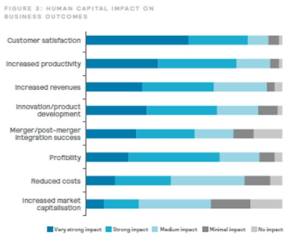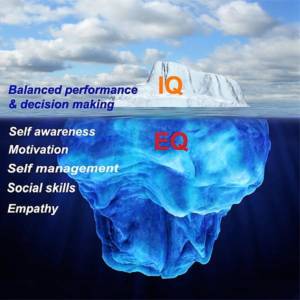…eventually be surrounded by “yes-man”!!!! Real Leaders don’t want yes-man around them!!! They want everybody tell them the truth even if it costs them their job!!
- How to train to become leaders and effective people managers?
- How to transform evaluation into an opportunity for growth?
- How to increase employee engagement?
- How to innovate manager training?

How important is it to invest in leadership and people management? Organizations that invest in leadership development perform better than those that don’t.
- Improve bottom-line financial performance. Companies that rate highly for their investments in human capital deliver stock market returns 5 times higher than those of companies with less emphasis on human capital. Leadership development builds capacity to reduce costs, drive new lines of revenue, and improve customer satisfaction.
- Attract and retain talent. Leadership development boosts employee engagement, increases the organization’s ability to deal with gaps in the talent pipeline, and reduces the headaches and costs associated with turnover. “Great leaders attract, hire, and inspire great people”. Developing, coaching, and promoting people internally is significantly less expensive than the costs typically required to hire someone externally.”
- Drive strategy execution. Effective leadership development isn’t development for its own sake. Organizations need a leadership strategy that closely connects with the business strategy and equips employees with the leadership skills needed to implement it. Leadership development allows organizations to shape the culture and strategy of business.
- Increase success in navigating change. Leadership development increases people’s ability to respond rapidly in unpredictable business environments. When organizations look beyond developing senior executives and high potentials to unlock the full potential of their talent pools, agility is magnified. Is a fact that when facing an unpredictable business environment, 86% of companies with strategic leadership development programs were able to respond rapidly. Meanwhile, just 52% of companies with less mature leadership programs could do the same.
Good human capital management impacts on:
- customer satisfaction
- productivity
- revenue
- innovation and development

The key word: ENGAGEMENT

Employees don’t leave a bad company – they leave a bad manager. Why? Because the everyday interaction managers have with employees can influence their level of engagement in the workplace.
Given leader/managers’ influence on employee engagement, it’s important that they feel empowered to improve employee training.
5 Ways Managers Can Improve Employee Training
- Set the example and foster a learning culture
A manager’s role in training and development is essential because they spend so much time with employees. Managers can use simple daily interactions to show employees that training is a priority. This constant interaction between manager and employee can be leveraged to improve training by consciously fostering a learning culture within the organization. An effective learning culture starts from the top, and is cascaded throughout all levels – no exceptions!
A successful learning culture promises:
- Increased productivity (and increased profit!)
- Improved employee satisfaction levels
- Decreased employee turnover
- A culture of knowledge sharing (rather than knowledge-hoarding)
- Improved learning agility
- Offer a deeper insight into employees
When designing a training program, many start by consulting subject matter experts. Why not include managers in the process too? One of the managers’ responsibilities towards employees is to ensure that they’re able to meet the requirements of their current job, and are prepared for upcoming changes. Most employees require frequent upskilling in order to meet the changes in their industry. Yet, only 61% of Americans feel that their employer provides sufficient opportunities for developing their technical and soft skills to keep up with advances. How can managers improve this statistic? By understanding where their team needs to improve today, as well as what skills they will need tomorrow. Given their knowledge of both specific job requirements, and the business’s development needs, managers are an invaluable source of first-hand information about which skills are most important to train employees in – whether it’s entry-level training for new recruits or reskilling long-serving employees.
- Communicate the value of employee development
What are the two major reasons why employees become disengaged and eventually quit? Because they feel stuck in a rut or like there is no clear path to progress. Even if your organization has a strong learning culture, it’s still important to make it absolutely clear that employee training and development is a top priority. A manager’s role in training and development includes communicating (both through words and action) that the company values their employees’ growth. The first step to valuing employee development is simply to make enough time for it. So when you train employees, give them the time they need to fully participate in training activities and complete assessments. Managers should also take care to recognize employee improvement both during training and on-the-job. This will help employees feel appreciated and motivated to keep growing.
- Create opportunities for on-the-job practice
New skills and knowledge gained during training simply won’t stick if learners don’t get a chance to apply them in the workplace. In other words, companies run the risk of wasting a significant portion of their training investment if employees aren’t given the opportunity to practice. Managers should collaborate with trainers to provide employees with opportunities to practice what they’ve learned in “safe to fail” spaces, like role-plays with colleagues, or eLearning scenarios and serious games. Finally, managers can provide hands-on supervision when employees apply trickier new skills in the workplace, or allow employees to complete a new task with them.
- Set training and performance goals
Author of 7 Habits of Highly Effective People, Stephen Covey, said “Stop setting goals. Goals are pure fantasy unless you have a specific plan to achieve them.” A key part of a manager’s role in training and development is to support their team in setting meaningful and achievable goals and plotting out the road to achieve them. Training goals should relate to job-specific skills. But they should also relate to broader professional development activities that help employees advance within the organization and realize their career ambitions. Managers have the privilege of working closely with employees to identify the knowledge and skills they’ll need for these goals in the short term and in the long run. Setting measurable KPIs is always advised, too – the cliché that what is measured can be achieved is worth taking seriously. Managers should work together with employees to establish areas for development, and find ways to quantify their goals. For example, a new sales employee may need to aim for 20% more sales per quarter after training is complete. The manager’s role in training also extends to communicating training expectations to their team. All employees should know how their participation in training will affect their performance reviews and advancement opportunities.

First of all WE need to know how to train and develop OUR EMOTIONAL INTELLIGENCE !!

